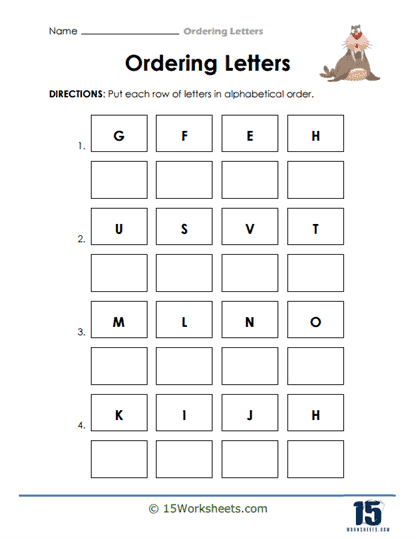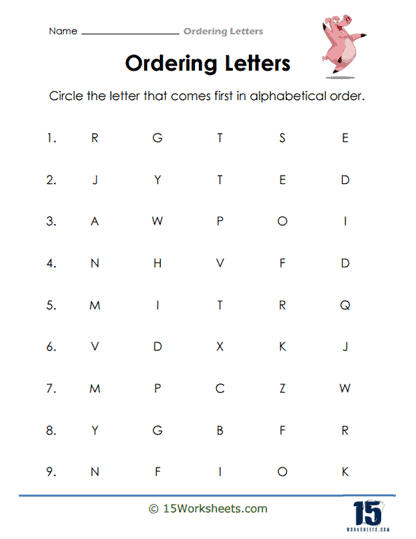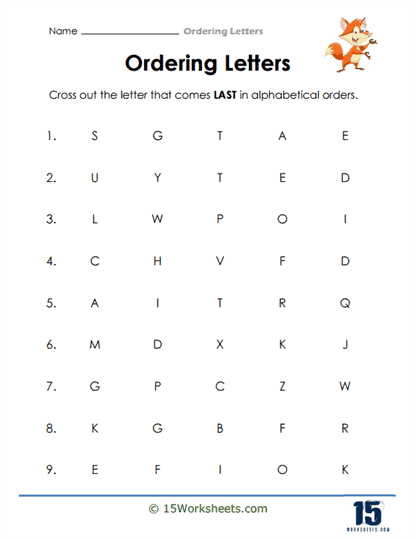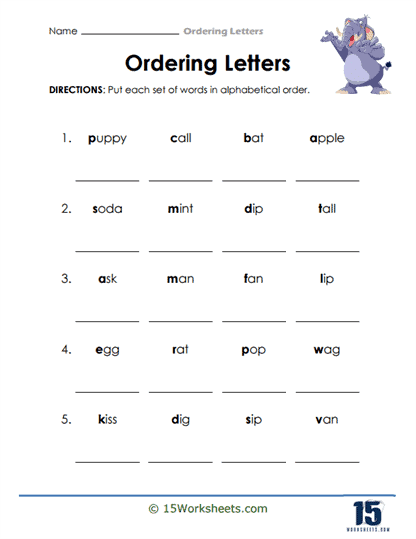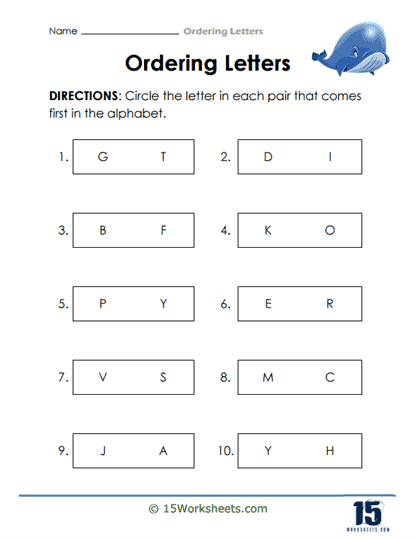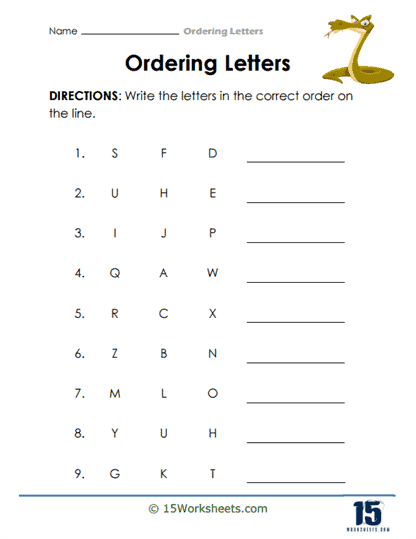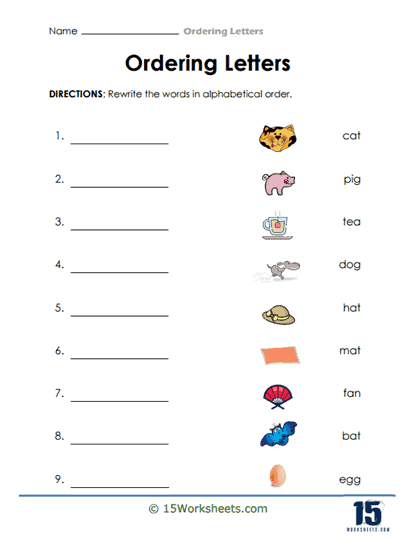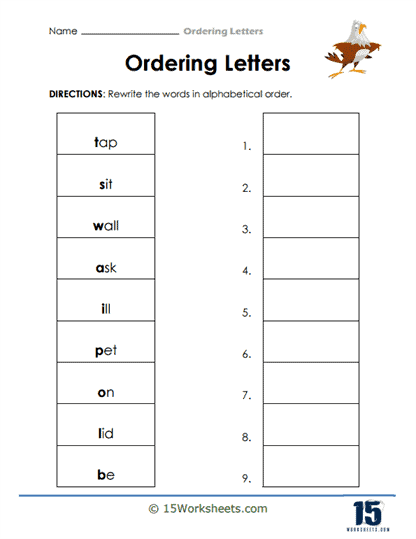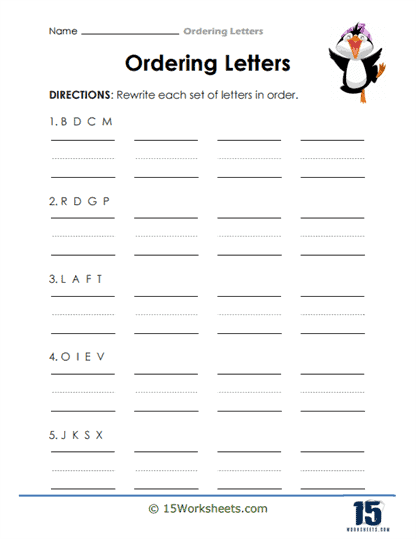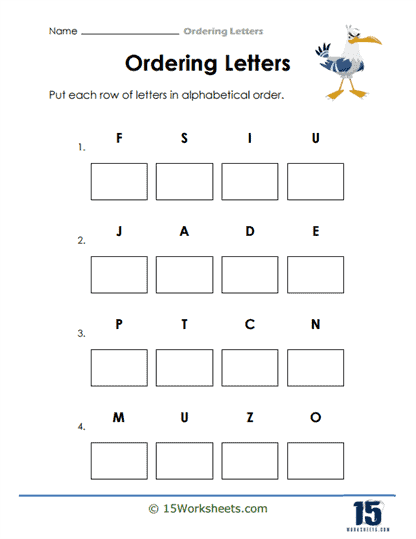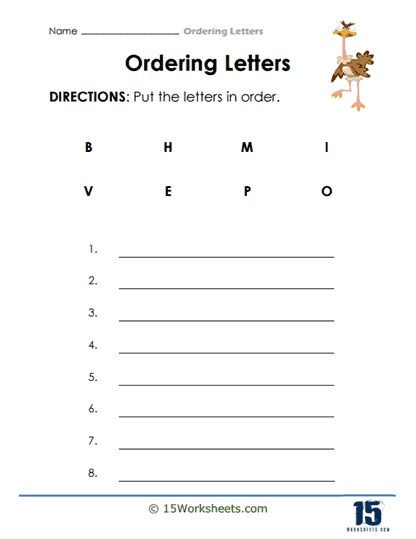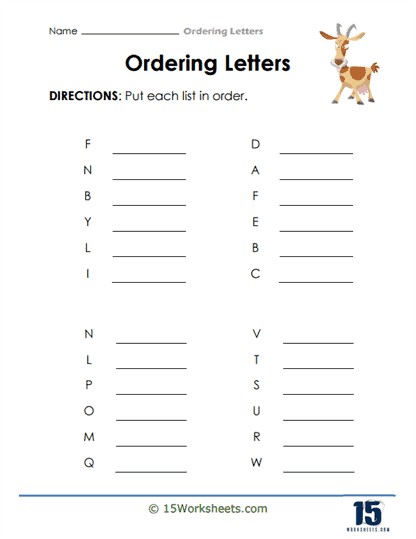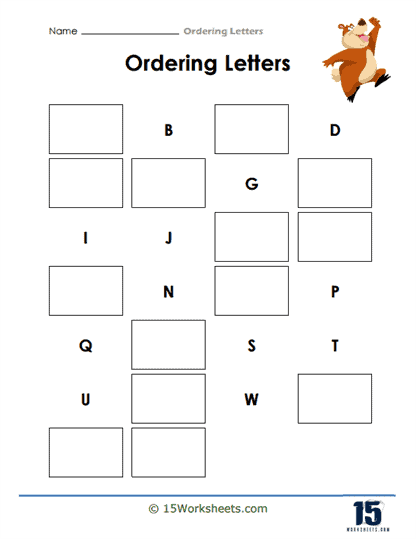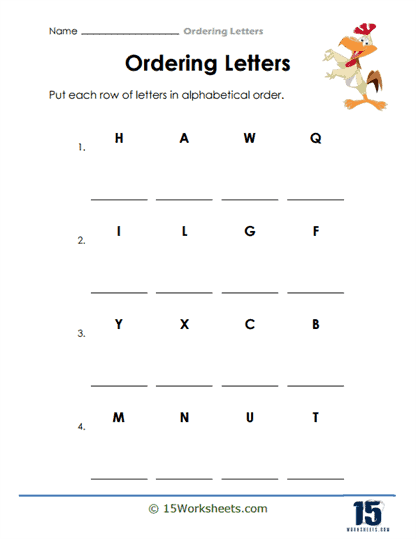Ordering Letters Worksheets
About These 15 Worksheets
The overall goal of these sheets is to help students develop their skills in alphabet sequencing. These worksheets focus on arranging letters of the alphabet in the correct order, both in uppercase and lowercase forms. The objective is to help children become familiar with the sequence of letters and reinforce their understanding of alphabetical order.
The worksheet usually presents a series of letters, either in uppercase or lowercase, that are initially jumbled or arranged randomly. The child’s task is to rearrange the letters in the correct alphabetical order. They may need to write the letters in the correct sequence or draw arrows to indicate the order.
The child starts by identifying the first letter of the alphabet and locates it among the given jumbled letters. They then proceed to identify the second letter, the third letter, and so on, until they have successfully ordered all the letters. You continue on with ordering the letters until they have correctly arranged the entire alphabet. This process helps reinforce the sequence and placement of letters in the alphabet. The sheets will reinforce a wide range of skills including:
Alphabet Recognition and Sequencing
These worksheets help children become proficient in recognizing and identifying individual letters of the alphabet in their respective uppercase or lowercase forms. By rearranging the letters in the correct alphabetical order, children develop their sequencing skills and understand the sequential nature of the alphabet.
Letter-Sound Correspondence
Letter-sound correspondence is a foundational principle of phonics instruction, which is a method of teaching reading that emphasizes the relationship between letters and sounds. Phonics instruction helps children decode words by associating the sounds of letters or letter combinations with their corresponding written symbols.
Letter-sound correspondence follows systematic patterns and rules in most languages. For example, in English, the letter “b” is associated with the sound /b/ as in “bat,” and the letter combination “ai” represents the sound /ā/ as in “rain.” While many letter-sound relationships in a language follow consistent patterns, there are also some irregularities where the relationship between letters and sounds does not conform to the usual rules. These irregularities require additional learning and memorization. For example, the letter combination “ou” in English can represent different sounds in words like “out” and “though.”
As children order the letters, they reinforce the connection between the letter forms and their associated sounds. Ordering letters worksheets can contribute to developing foundational skills for writing by familiarizing children with the order of letters they will encounter in words.
In What Order Should You Teach Student Letters?
The order in which letters are taught to students can vary depending on instructional preferences and curricular approaches. However, there are a few commonly used methods and principles that can guide the sequencing of letter instruction. Here are three common approaches:
Alphabetical Order
Teaching letters in alphabetical order is a straightforward and systematic approach. It follows the traditional sequence of the alphabet, starting with “A” and progressing through to “Z.” This approach ensures that all letters are introduced, and it provides a logical and predictable sequence for students to follow.
Frequency Order
Another approach is to introduce letters based on their frequency of use in language. This method prioritizes teaching letters that occur most frequently in words. Commonly used letters such as “E,” “T,” “A,” and “O” are typically introduced early on, followed by letters that occur less frequently. This approach allows students to encounter and practice letters that are most commonly used in reading and writing.
Letter-Sound Correspondence
Some instructional approaches prioritize teaching letters that represent the most common sounds in the English language. This approach focuses on introducing letters that have high utility for decoding words. For example, letters like “M,” “S,” and “P” are introduced early because they represent commonly occurring sounds. This approach allows students to quickly apply their knowledge of letter-sound relationships to reading and spelling.
It is important to consider students’ developmental readiness and instructional context when determining the order of letter instruction. Some factors to consider include students’ prior knowledge, their phonological awareness skills, and any specific curricular guidelines or scope and sequence documents provided by educational programs.
Tips for Teaching Alphabetic Order
When teaching alphabetic order, there are several effective strategies to engage and support students in learning this skill. One helpful approach is to use visual aids such as an alphabet chart or line displayed in the classroom. This visual reference provides a clear sequence of letters for students to refer to as they practice alphabetizing. Hands-on activities, such as arranging letter cards or creating a human alphabet line, can also reinforce the concept of alphabetic order in a tangible way. Singing alphabet songs can be both fun and memorable, providing students with a rhythmic and melodic way to internalize the order of letters. Incorporating interactive games, like “Alphabet Race,” where students quickly arrange letter cards, adds an element of excitement to the learning process.
You can also create alphabetical stories or sentences using words that start with different letters, challenging students to arrange them correctly. Providing word lists for students to organize in alphabetical order helps connect the skill to vocabulary and word recognition. Starting with a few distinct letters and gradually introducing more complex sequences allows students to build their skills incrementally. Regular repetition and review, along with real-world examples of alphabetical organization, such as dictionaries and library catalogs, reinforce the importance and relevance of alphabetic order. By implementing these strategies, students can develop a strong foundation in alphabetic order, enabling them to navigate and organize information effectively.


